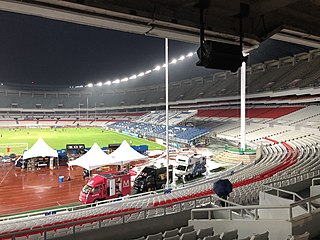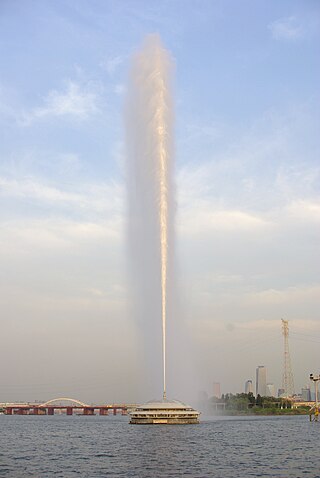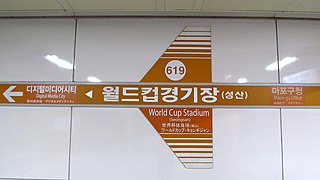
The Seoul World Cup Stadium (Korean: 서울월드컵경기장), also known as Sangam Stadium, is a stadium used mostly for association football matches. The venue is located in 240, World Cup-ro, Mapo-gu, Seoul, South Korea. It was built for the 2002 FIFA World Cup and opened on November 10, 2001. It is currently the second largest stadium in South Korea after Seoul Olympic Stadium, and is the 2nd largest rectangular stadium in Asia. It was designed to represent the image of a traditional Korean kite. The stadium has a capacity of 66,704 seats, including 816 seats for VIP, 754 seats for press and 75 private Sky Box rooms, each with a capacity for 12 to 29 persons. Due to table seats installation, capacity was reduced from 66,806 seats to 66,704 seats in February 2014. Since the World Cup it has been managed by the Seoul Metropolitan Facilities Management Corporation (SMFMC). FC Seoul moved to the Seoul World Cup Stadium in 2004.
The 1960 AFC Asian Cup was the 2nd edition of the men's AFC Asian Cup, a quadrennial international football tournament organised by the Asian Football Confederation (AFC). The finals were hosted by South Korea from 14 October to 23 October 1960. The final tournament was organised on a round robin basis, and host country South Korea won with a perfect record of three wins.

Dongdaemun Stadium was a sports complex in Seoul, South Korea and included a multi-purpose stadium, a baseball park and other sports facilities. It was located near Dongdaemun or Great East Gate. The surrounding Dongdaemun market had many vendors selling athletics-related goods. It was demolished in 2008 to make way for the Dongdaemun Design Plaza & Park.

The Seoul Olympic Stadium, also known as Jamsil Olympic Stadium, is a multi-purpose stadium in Seoul, South Korea. It is the main stadium built for the 1988 Summer Olympics and the 10th Asian Games in 1986. It is the centrepiece of the Seoul Sports Complex in the Songpa District, in the southeast of the city south of the Han River. It is the largest stadium in South Korea.

Anyang Sports Complex is a group of sports facilities in Anyang, Gyeonggi, South Korea. The complex consists of the Anyang Stadium, Anyang Indoor Arena, swimming pool, ice rink, and tennis court.

The World Cup Fountain was a fountain built to commemorate the 2002 FIFA World Cup co-hosted by South Korea and Japan. The World Cup Fountain is located in the Han River in Seoul, South Korea, between the World Cup Stadium and Seonyudo Park. The fountain jets water at a height of 202 metres (663 ft), a symbolic gesture to the year the FIFA World Cup was held in Seoul. The fountain is taller than the Gateway Geyser, or the fountain in Fountain Hills, Arizona or the Port Fountain in Karachi, Pakistan. For comparison, the Washington Monument in Washington D.C. is 169 meters tall.

Seoul Nowon United FC is a South Korean semi-professional football club based in Nowon District, Seoul. It currently competes in the fourth tier of the South Korean football league system, the K4 League. Until 2018, the club was named Seoul United FC.

The Mokdong Stadium is a South Korean sports complex located in Mok-dong, Yangcheon-gu, Seoul. It consists of a multi-purpose stadium, a baseball stadium, and an artificial ice rink. It was opened on 14 November 1989. The main stadium hosted K League football matches from 1996 to 2001.

The World Cup Stadium Station is a metropolitan subway station in Seoul, Korea. The station was built to facilitate access to the Seoul World Cup Stadium for 2002 FIFA World Cup. The station has a very specific design with a main entrance reminiscent of a Greek amphitheater, between Exits 2 and 3.

The Kim Koo Museum is a museum in Seoul, South Korea which opened on October 22, 2002, to commemorate the life and thoughts of Kim Koo, a Korean independence activist against the Japanese occupation of Korea. This museum and library is located within Hyochang Park in Hyochang-dong, Yongsan-gu, Seoul.

Hyochang-dong is a ward of Yongsan-gu in Seoul, South Korea.
Football is one of the most popular sports, both in terms of participants and spectators, in Seoul. Seoul had several of South Korea's leading football clubs and biggest football stadium - Seoul World Cup Stadium.

Hyochang Park is a park in Yongsan Districtof Seoul, South Korea. It was originally the cemetery of royal noble consort Ui of the Seong clan, her only son Crown Prince Munhyo, and of the Sugeui Park clan, and was known at that time as Hyochangwon. The Japanese Empire developed Hyochangwon into a park in 1924 and the Japanese Governor-General assigned Hyochangwon park status in 1940. At the end of the era of the Japanese colonization of Korea, as the grave of the Crown Prince Munhyo was forced to be moved to the royal tomb of Sepsam, Hyochangwon became Hyochang Park.
Israel competed at the AFC Asian Cup four times. In 1956 and 1960 Israel finished second, in 1964 they finished first, and in 1968 they finished third. In 1972 Israel qualified for the tournament as hosts but later withdrew.
The 1962 FIFA World Cup UEFA–AFC qualification play-off was a two-legged home-and-away tie between the winners of UEFA Group 10, Yugoslavia, and the winners of the AFC final round, South Korea. The matches were played on 8 October and 26 November 1961 in Belgrade and Seoul, respectively.
National football teams from Vietnam has qualified for five AFC Asian Cups so far:
Chinese Taipei national football team or Taiwan has participated in two AFC Asian Cup since it was founded.

The Oil Tank Culture Park is a renovated public park located in Mapo, Seoul, South Korea.
The Asian section of the 1962 FIFA World Cup qualification saw three teams enter and compete for a partial spot at the final tournament.













